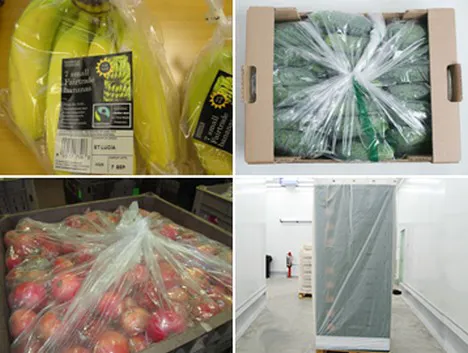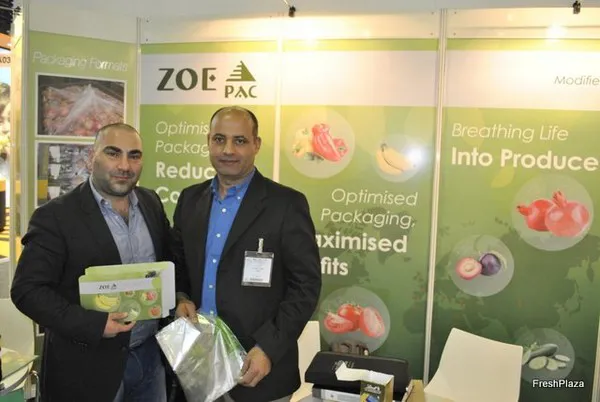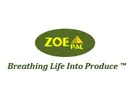They have had biodegradable and recyclable packaging options for the last five years. However, until recently, there was not so much demand for these. “Partly because of the costs,” says Athanasios Mandis, Zoepac’s Commercial Director.
“This kind of packaging has not been so widely adopted because of these costs - which is understandable – but the costs and availability have been coming down, and consumer pressure on sustainable packaging has been increasing. We are, therefore, confident that in the next few years, there will be a transition from fossil-fuel-based plastics to either recyclable or biodegradable plastics. ”
However, the company remains comfortable with its use of plastic and its carbon footprint. “We are focused on modified atmosphere packaging. Our packaging is not just for carriers. The savings our packaging has regarding carbon and water far exceeds our products’ carbon footprint,” says Athanasios.
Comparison of bananas stored in a ZoePac bag versus unpacked.
A packaging solution for every product
“We have developed packaging solutions for all of the major horticultural products - whether it be fruit, vegetables, herbs, or leafy vegetables. We also have solutions for some of the more challenging products like tomato, bell pepper, and basil. We have some unique solutions for these.”
“In terms of modified atmosphere (MA) packaging, our position has always been that we want to distinguish ourselves from the usual plastic or carrier bags which are used only for convenience,” explains Mandis. Fundamental to this is also the carbon footprint. “Our MA bag obviously has a carbon footprint as well. But, the difference comes in prolonging the product’s shelf life and reducing shrinkage in the supply chain caused by loss of retail value, wastage and moisture loss.”
“Then the saving on embedded water and carbon from transportation, and fossil fuel-based fertilisers and chemicals is significant, from an environmental, carbon footprint perspective. That has always been one of our core policies and strategies. But, that issue is now becoming better understood, and there is a greater demand from our customers.”

Agents in more countries
“What is new is the last year or so, is having representation in new territories. That includes Peru and Turkey. We are also in discussions with India and West Africa. So, we are expanding our presence. We have always been international, serving international clients, but having an agent in-country to provide that customer service is critical,” says Athanasios. That global expansion in representation has been a recent area of focus for the company.
“A big advantage of having agents and representatives is that they know the business and country in which they are based. A lot of times, when clients need packaging, they are not thinking three or six months in advance. They start the season and suddenly realize they need packaging.” When someone places an order, Zoepac has an active lead time of four to eight weeks. “The beauty of having agents in-country is that they manage that relationship, they think of packaging in advance so they can respond to the clients’ demands, to avoid these lead times.”
Does the company have to use different technologies for individual products? “The composition of the polymers which make up the film can change. All of our packaging is breathable for bulk gaseous and moisture exchange. This differs from some other companies which have a non-permeable plastic film. What they do is, they calculate a product’s theoretical respiration rate, and then they make several holes in the film to accommodate this respiration,” says the Commercial Director. “This can be crude, macro perforations or more sophisticated laser technology."
Limited approach
“The limitation of this approach is that it is based on a theoretical model. The reality of the product may change - it may not be as healthy, or there is a break in temperature in the cold chain. Then, all of a sudden, the product’s respiration is greater than was anticipated. Then, because you are basing your whole design on these holes, you have some limitations.”
“Our advantage is - because we design the film to be permeable - our packaging tends to accommodate these variations and cold chain breaks more effectively. But in terms of our approach, one of our unique selling points is that we are experts in postharvest technology. We know about fruit and vegetables, and how they behave,” says Athanasios.
“So we understand their respiration rates, how much ethylene they produce, or how much sensitivity they have to ethylene or moisture. We, therefore, know what we need to design when it comes to film. Are we going to go for high moisture retention like what is needed for leafy vegetables or herbs? Or do we go for very low moisture retention? This solution will suit products like melons. And also, with retailers where temperatures are high, you want to remove moisture significantly.”

Athanasios Mandis and Adnan Sabehat from ZoePac.
Specialised in more than just packaging
“For example, how much oxygen and carbon dioxide do we need to maintain? This must be balanced with the necessary shelf life extension in terms of ripeness and discoloration,” adds Athanasios. These are some of the considerations Zoepac needs to keep in mind. “Along with the polymer science, marrying these things, we feel, distinguishes us from other MA packaging companies. They may be specialised in packaging, but not necessarily produce.”
All of Zoepac’s film and packaging are manufactured in Israel. “There are two stages of production. The first is preparing the polymer, and the other is cutting the polymer to size. We can either prepare the polymer as a roll and then the final preparation is done. Or, the polymer is prepared, and the packaging is done in-country. If and when we reach critical mass, then we can consider this option. We can explore this, depending on the relationship we have with the customer in that country and if their demand is big enough. With one or two supply chains and customers, things are advancing toward these kinds of discussions.”
Overcoming the challenge of using plastic
According to Mandis, the reasons plastic is used so abundantly is because it is cheap and very convenient. “The bigger problem with plastic is when it is used solely as a carrier or for convenience. Then this product’s carbon footprint is an issue. When you look at commercial agricultural produce, a lot of energy is used, in terms of pumping water and preparing the lands. Fossil fuels are also used, then there are fertilizers and chemicals. Water is being used for irrigation, and there is refrigeration. There is cold storage and shipment, as well as fuel for the shipments too.”
“So, within produce, there is an embedded carbon and water footprint. On a global scale, in excess of a third of all production is lost due to postharvest losses. That is not just a loss of food, which impacts food security. That is a loss of carbon and water that is embedded in that produce too. So, yes, we use plastic, which has a carbon footprint. But that carbon footprint significantly reduces the carbon footprint associated with postharvest losses.”
“From that side, our products have many benefits. There is a separate debate around plastic disposal.” Athanasios thinks that is something that needs to be discussed. “How do we prevent plastics from getting into our water sources? We recognise that this is a problem. I think that is something that, as an industry, and community, we need to come together over. This issue cannot be addressed by one company alone,” he concludes.
You can find Zoepac in HALL B (City Cube) Stand no. C16
For more information: 
Athanasios Mandis
ZoePac
Tel: +44 (0) 1227-211-080
Email: atha@zoepac.com
www.zoepac.com
